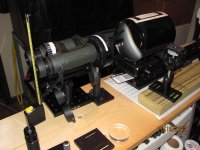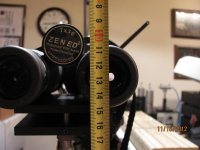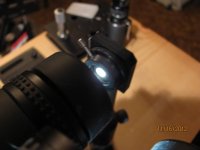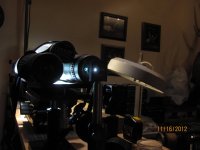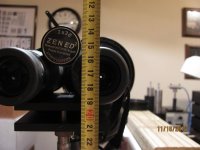The exit pupil, the bright round spot of light that appears in the eye lens when you hold the objectives up to the light, is a sharply focused virtual image of the objective lens. This can be confirmed by laying a ruler or any small object over the objective, almost in contact with the glass. Then, if a loupe is used to view the exit pupil, the test object will be seen clearly focused. The outline of the exit pupil is the image of the objective's edge, unless there are other more limiting internal stops.
If an aperture smaller than the exit pupil (like the eye's iris, contracted by bright light) is centered on the exit pupil, it will block light from the outer portions of the objective lens, just as it blocks the image of the outer parts of the objective lens in the exit pupil.
Am I missing something?
Ron
Ron, you just answered it yourself in your question. The only thing you missed is the part about the occluded edges. All the light in the bino exit pupil is in bundles, throughout the exit pupil, all principal rays of all the objects in the field stop pass through the center of the exit pupil as well as parts of the exit pupil the axis angle permits. This is why the eye can roam around a full exit pupil and see everything until you get close to the edge.
Henry Link and FrankD, the best objective and subjective reviewers on this site, along with many others, have made comments like those quoted below:
http://www.birdforum.net/showpost.php?p=2492973&postcount=10 Henry Link
“1) Greater viewing comfort: Large exit pupils are very forgiving of eye placement compared to small ones. I’m quite used to the easy view now, so ALL 4mm exit pupil binoculars feel overly sensitive to pupil placement.”
http://www.birdforum.net/showpost.php?p=2418624&postcount=7 FrankD
“1) …………………………………………………………………………I think it does help but I also think the larger exit pupil allows my eyes more room to roam around the image. I also think the increased depth of field provides a more relaxed and natural image for my eyes.”
http://www.birdforum.net/showpost.php?p=2529829&postcount=319 Chosun Juan
“Blackouts:
* Not really an issue for me, and my eyes were free to roam most of the field, even if not to the very edges before some darkening crescents began to appear. I should note, that it is my viewpoint, that set-up is fairly critical on this 10x42 bin. The combination of shallow dof, long ER (which I used fully), only 4.2mm EP, large oculars, and exacting Exit Pupil minima as I described, mean that ER, IPD, and Diopter settings, have to be precisely set, and eye placement, precisely positioned, in order to get the best view.”
These are just a few samples; but I have seen the comment repeated over and over again.
If the eye can roam around the exit pupil, it does not seem it is being stopped down by the eye to “match the pupil diameter, same as and 8x20”, does it?
As long as there is a full exit pupil, the binocular aperture is unstopped and full resolution and MTF are available in the exit pupil. If you physically stop the bino down then all the optical parameters change, f#, DOF, light cone, etc. None of these change when viewing with a 2 mm eye.
What is stopped down is the eye. The eye reacts to stopping down just as a lens. The limiting resolution goes down, the effective focal length changes and the DOF may or may not change, it is so deep anyway it would be hard to know if there is a measurable difference.
The binocular is just a lump of parts that cannot change its self. Optics theory says that optics is bi-directional, which is true, but light is directional, from the source to the observer. Just like a car going down a highway, when it hits bumps, goes around curves, or through a tunnel that is small enough to remove the top, if after the car passes those points, changing them will have no effect on the car. The same is true of light, going through the bino, the rays react to the diffraction of lenses, clipping in the prisms, etc. until it forms its final image at the exit pupil. No changing of parameters after the exit pupil will affect the exit pupil.
I do not know how this opinion got started, but I have not seen it in any books. The closest thing I have seen is that someone said that when the eye is stopped down then it would be as if looking through a stopped down telescope as far as resolution, unless the difference is made up by magnification. I don’t know but the only place I seem to be able to find this idea is in opinion forums.
I have done a lot of testing over the past several years, taking various optics and measuring resolution, placing an aperture stop in front and stopping the exit pupil down to 2.5 mm, then removing the aperture stop and moving it to the exit pupil and setting the iris at 2.5 mm. The results to the eye are the same as far as resolution, but with an exit pupil stop the binocular is operating at full aperture, only the eye is stopped down. The resolution for the aperture stop and exit pupil stop is the same at the eye.
I could go on for pages and pages about things I have tried to prove the eye stops down a bino and they all failed miserably.
PS: Forgot, a lot of this was discussed in the thread about wasted exit pupil and another thread about larger bins in general.




